Marantz NR1711
Product Name: Marantz NR1711
Product Description: 7.2 CH 8K AV Receiver
-
Design - 9.8/10
9.8/10
-
Audio Quality - 9.2/10
9.2/10
-
Inputs / Ports - 9.4/10
9.4/10
-
OS, Apps and Features - 9.6/10
9.6/10
-
Price / Quality - 8.5/10
8.5/10
Summary
Total Score
Pros
- Great sound performance
- Compact design
- HDMI 2.1 support
- Huge feature list
Cons
- No front HDMI input this year
- HDMI 2.1 has problems with 4K@120Hz
- No backlight on remote
- A bit expensive
Cheapest Places to Buy :
*We are a reader-supported website. When you buy through links on our site, we may earn a small affiliate commission at no extra cost to you. Home Media Entertainment does not accept money for reviews.*
For one more year all major AV receiver manufacturers rolled out their new units and the big news this year is obviously 8K support and HDMI 2.1. In general we have not been very fond of these yearly releases as there is far too little in terms of updates to warrant a new release but it seems that most major manufacturers seem to disagree. Marantz is one one of them, being part of Sound United, and have during the summer released all their latest offerings as always. In our Marantz NR1711 review today we will be looking at the top offering in the slim-line series that promises to offer everything the other full sized receivers have but in a smaller package.
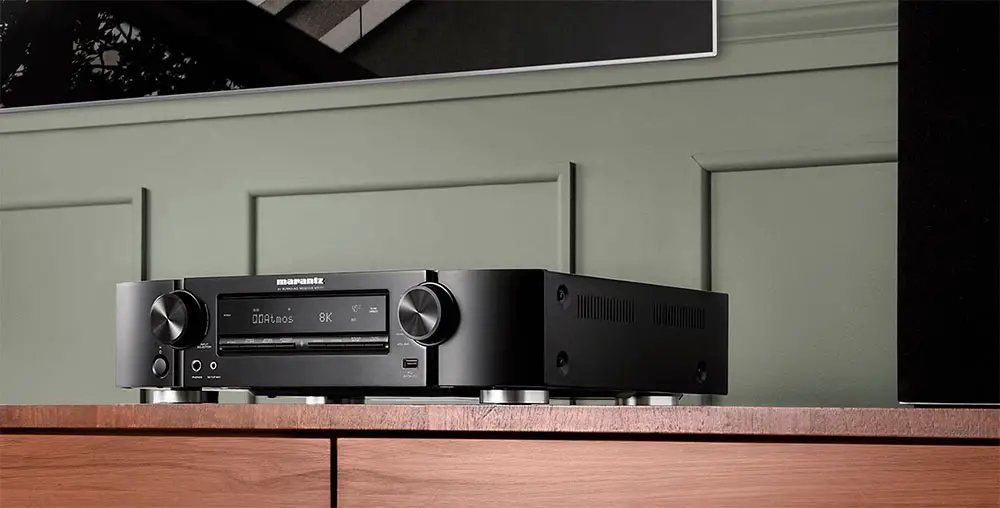
We were always very fond of this slim-line series and this because they are exceptionally designed for those that want a fully featured AV receiver but don’t have the space for a full sized unit. As such the NR1711 offers an elegant solution that can fit almost anywhere and comes with an astonishing list of features that will surely please even the most demanding of users.
The new 2020 NR1711 is a 7.2 channels receiver with 50 watts per channel, supports Dolby Atmos and DTS:X formats, Dolby Surround and DTS Neural:X up-mixing technologies as well as Dolby Atmos Height Virtualization and DTS Virtual:X virtual technologies. It comes with Audyssey MultEQ audio calibration system and packs a huge list of extra features like HEOS, Airplay 2 and High Resolution Audio while for 2020 we also find 8K/60Hz or 4K/120Hz resolution support along with HDMI 2.1. The new port supports a few new technologies like Variable Refresh Rate (VRR), Quick Media Switching (QMS) and Auto Low Latency Mode (ALLM) which we will analyze in the following sections.
So how does this little receiver performs and are the extra new goodies enough to make it a worthwhile upgrade? Let’s find out…
Design
Marantz has not changed the outer shell design of the NR1711 and except from the naming at the front along with a missing front HDMI port which we will talk about shortly everything else has remained the same. The NR series was always unique as their low profile allow them to fit in places that a full sized AV receiver wouldn’t be able to. And this lower profile, except from the obvious practical advantage also offers a more elegant look. Because let’s be honest here, AV receivers are just black boxes with some buttons on them and never will win any design awards. But the NR1711 differentiates itself with its more compact looks making it vastly more pleasant to the eye and less distracting.
As such when it comes to its dimensions and weight we find exactly the same numbers as the last few years which is not surprising. The NR1711 measures just 17.3″ x 14.8″ x 6.8″ (440 mm x 378 mm x 175 mm) with the antennas in a vertical position but you can lower its height even further to just 4.1″ (105 mm) by turning them to a horizontal position without affecting the signal in any significant way, at least from some tests we did. And if you take into account its weight which measures 18.3 lbs (8.3 kg) handling and placement could not be any easier and you can really fit this in very tight spaces and furniture.
But size is not the only part of the receiver that has remained the same as the general look and buttons layout is completely similar to last year’s NR1710. And here is another area where the NR series excels. They offer a fully functional front layout as any full sized receiver does but at a smaller size. As such we get the usual two big knobs configuration with the left one used for input selection and the right one for volume control while a fully functional display sits between them.
Under the left knob there is a circular button for powering the unit while under the central display we get a thin line with two groups of four buttons each. At the left one we get M-DAX, Zone 2 controls and internet radio while on the right one the usual dimmer and status buttons, sound mode selection and pure direct.
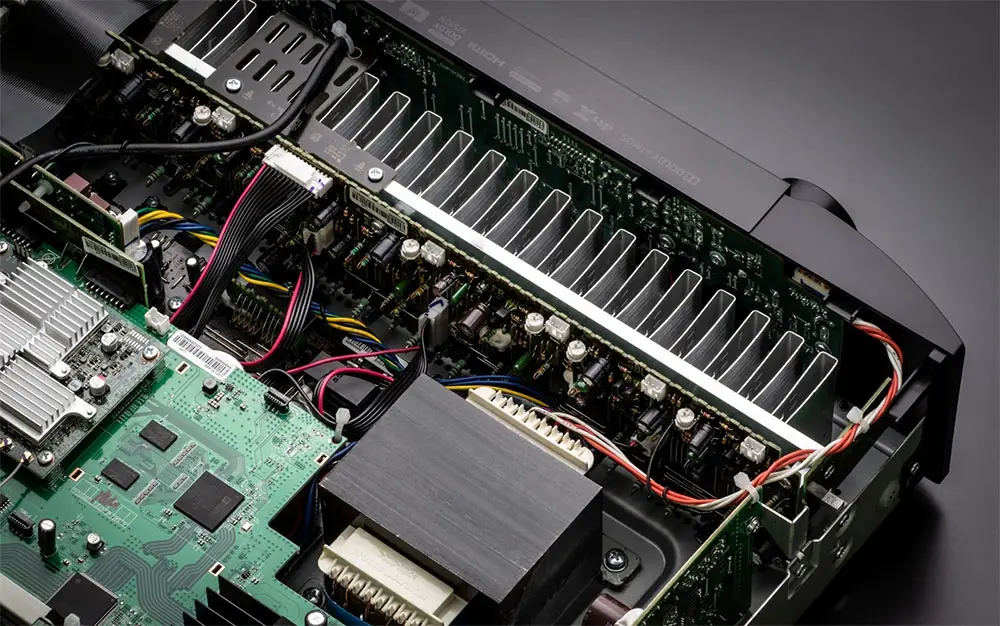
We also find a few front connections as per usual in all AV receivers that are meant for easy and quick access and are placed under the two big knobs. These include the common headphones jack with the calibration microphone placed right next to it while on the other side a USB port (5V, 1A) can be used for connecting external storage. Now here is the only major difference we find compared to last year as the NR1711 does not come with a front HDMI port which is a major step back in our opinion. A front HDMI is always useful if you want to connect a gaming console to play with a friend or some projector. This was a major mistake in Marantz part and we are disappointed to see this happening.
With the number one factor obviously being the size the engineers at Marantz really continue to excel at giving us a high quality product in a small form. The NR1711 may not have the internal components that some of its full sized brothers are advertised with but even so this small AV receiver uses a high-current discrete power amplifier while featuring identical power on all seven channels ensures low-impedance drive capability for better speaker control.
For the DACs Marantz has used 32-bit AKM AK4458 D/A converters on all channels for optimum fidelity and the widest dynamic range with the lowest distortion. This ensures consistent high-fidelity and precise channel matching across all channels for the best listening experience possible.
Moving on to the included remote it seems there is no major change from last year also. Code named RC042SR the different naming indicate some changes and basically what have changed is the functionality of one button as the AUX2 which was used for one of the HDMI inputs has been switched to 8K for the HDMI 2.1 port located at the back.

As for the actual design since everything is the same our opinion is similar to last year. There is a lot of space between the buttons but we feel they should be slightly bigger to give a more comfortable touch. At least adequate space between them ensures you will not accidentally press the wrong button in the dark as there is no backlight function here that could help. Also with the buttons available we believe that the remote could shrink a little to be easier to handle.
The top of the remote is where all of the inputs are located with the only change being the 8K button that we mentioned above while volume, channels and navigation controls are placed in the middle as we usually see followed by three playback buttons with four selection buttons underneath them. At the bottom we get four colored sound modes to choose from. Nothing fancy but not bad either. It has a nice texture surface that makes it look more interesting but would definitely like to have a backlight that can be a huge improvement in terms of usability.
The NR1711 continues the tradition of the NR series by offering excellent build quality in a smaller form. We have no problem that Marantz kept the same design but we were deeply disappointed to see the front HDMI go which is a major back step in our opinion.
Audio Quality
In terms of its core audio characteristics the NR1711 comes with exactly the same specs we saw in the NR1710 last year so no real surprises to be honest. The NR1711 has 7 channels of built-in amplification with a rating of 50 watts of power per channel (8 ohm, 20 Hz – 20 kHz, 0.08% THD) which makes this receiver ideal for a small sized Dolby Atmos 5.2.2 audio setup with the ability to connect up to two subwoofers.

As for the actual audio we find support for the most common formats including Dolby Atmos as well as DTS:X. Also included are Dolby Surround and DTS Neural:X up-mixing technologies which are capable of remixing mono, stereo or multi-channel formats into as many speakers your setup is using.
One feature that was added last year and continues into 2020 is the addition of Dolby Atmos Height Virtualization which is capable of creating overhead effects even if you don’t have any physical speakers in these positions. Additionally we get DTS Virtual:X which is the equivalent virtual tech that can simulate surround and overhead effects even if you don’t have any real speakers there. One thing we should mention is that while Dolby’s tech can work with either Dolby or DTS signals, DTS Virtual:X works only with DTS ones which slightly limits its use.
Since the NR series is mostly destined to be used in more confined spaces and small rooms our testing is a bit different compared to a fully sized AV receiver that offers much more power in comparison. Firstly we test a movie using a standard 5.1.2 Atmos setup with two height speakers connected in the middle of our listening area and then we retest the movie by using a simpler 5.1 channels system and using the included Virtualizer to determine if we can get a similar performance but without the need to add dedicated height speakers.
The movie we tested the receiver with was Greyhound with its totally breathtaking Dolby Atmos mix which is really an amazing movie by the way and if you like WWII films you will find this one really interesting. Now with our system set into a 5.1.2 channels configuration the NR1711 offered us exactly you would expect from a Dolby Atmos AV receiver but on a smaller scale.
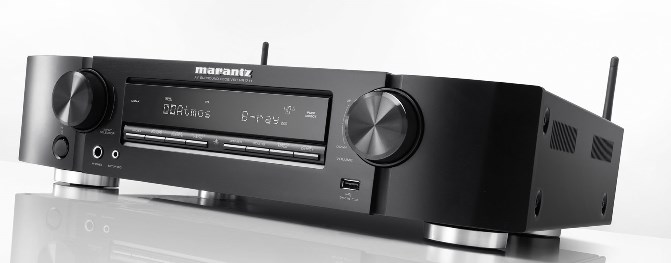
The film is very much isolated on board the USS Keeling, a Fletcher-class destroyer with the responsibility to escort Allied convoys across the Atlantic. Dialogue is constant as the captain desperately tries to give orders to the crew that would save not only the other ships in the convoy but themselves also. There are moments when the USS Keeling is throwing everything it’s got to the German U-boats while the captain is screaming his commands to his sailors. The NR1711 did an amazing job at keeping this audio spectacle under control at all times. The dialogue was kept nicely isolated at the center even through all this noise and action.
Cannon fire, machine guns and depth charges all had a very raw acoustic tone to them and really felt very realistic and true to life. Each channel showed nice separation while panning effects felt very precise and to the point. There was a very nice transition from the front to the surrounds and the NR1711 made sure to keep the changes as smooth as possible. The film is not very Atmos driven but there are moments where elevated effects show up and do give the film an extra dimensionality that ups the atmosphere immensely.
Lastly our subwoofer was fed with all the low end it needed and a film like Greyhound has plenty of shaking to offer. Depth charges had nice volume, machine gun and cannon fire were punchy and with great oomph while the explosion of each U-boat or ship offered a nice shake to the whole room.
As a whole we can say that the NR1711 performed exactly as a full sized AV receiver would. Good separation between the channels, nice panning effects, effective Atmos action with nice resolution and very satisfying low end action. So if you are afraid that the unit is missing anything compared to its bigger brothers you really shouldn’t.

Now as the NR1711 is destined to be used in confined spaces and rooms where space for speakers placement is rather limited the use of virtual technologies become more of a necessity. And this is where Dolby Atmos Height Virtualization comes into play and it’s these situations where such technologies can really benefit the user. As we switch to a 5.1 channels setup we used the Height Virtualizer to see if we could get a similar kind of immersion as we did when we had actual height speakers.
We always say that these virtual technologies vary in performance greatly depending on your room along with the kind of content that are used with. In our situation we rerun some of the Greyhound scenes to see if we could sense any major differences now that the Atmos speakers were missing. There was an obvious lack of overhead activity this time but we still got some elevated action that we wouldn’t get if we were using a simple 5.1 channels system without the Virtualizer. The soundstage had great volume, depth and good height. It just didn’t manage to reach the levels we were hearing before.
Keep in mind that the smaller you room the more pronounced these effects will be. In a wide open area these effects will diminish greatly but in small rooms where this AV receiver will be ideal the Dolby Atmos Height Virtualizer can do a damn fine job at adding some extra immersion. Is it as good as having dedicated speakers? Hell no. But that doesn’t mean that there is not some short of improvement. And anything that can add to the immersion is welcome.
Lastly we should talk about the overall power of the NR1711 as with only 50 watts per channel you may be worried if it is enough to give you some satisfying high volume. And here as we mentioned before everything depends on the room you have. Obviously the receiver cannot go to the extremes but it was not designed to do so. As you will most likely use it in a confined space the NR1711 can go pretty high to offer you a satisfying result. If you keep your expectations at check then you will have no problem enjoying it to its maximum.
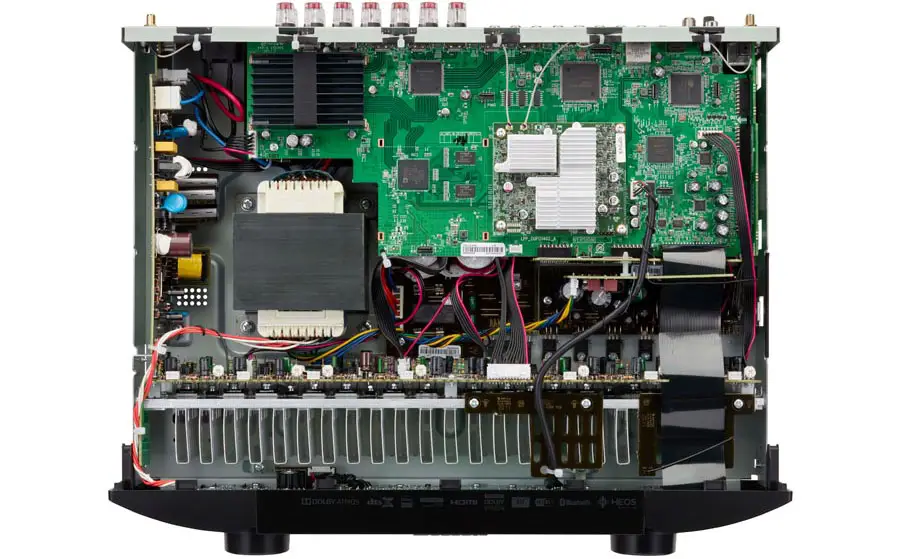
The NR1711 also retains all the characteristics that made the previous models such good music performers. As such this receiver supports not only the usual lower quality audio formats like MP3, WMA (up to 192 kbps) and AAC but can also playback High Resolution Audio in the likes of FLAC, ALAC and WAV files up to 192 kHz / 24-bit quality. DSD streaming is also available for both 2.8 and 5.6MHz.
For this testing, as we usually do, we selected a few favorite tracks in FLAC format that we streamed through the front USB port for the best quality possible. As for how it did, the NR1711 was really a pleasure to hear at. We have said before that these NR receivers may be lacking in pure power but high volume is not everything. The NR1711 was able to give us an amazing music performance as it made the soundstage feel alive with excellent resolution, good mid-range and energetic highs. The low end provided the necessary weight while everything came together nicely and will make you hear in disbelief that so good quality audio can come out of such a small box.
In terms of pure audio performance the NR1711 is as good as it can ever be. If you are not particularly power hungry and you have a small room you want to turn into a nice Dolby Atmos home theater then there is no better choice than the NR1711. It has the quality to up the immersion in a smaller scale and does that in a very masterful way.
Ports and Connectivity
If you have no previous experience with the NR series then you may believe that due to its smaller size the available connections would be rather limited. With the NR1711, as with all the top units in the NR series, this could not be more far from the truth as this receiver has practically everything you would need for a small sized home theater system. It may not have the number of connections or some more advanced types that we only see in the top models but in terms of variety you will find that it has plenty to offer even if in lower numbers. We did mention already about the available fronts at the front with the headphones jack, the microphone port and the USB as well as noting the missing front HDMI input.
As for the back most of the layout has remained untouched with one glaring difference. But lets see everything separately. The first and most obvious ones are the speaker terminals as there are seven of them with the last two being assignable and can be used to connect either an extra pair of surround speakers or Dolby Atmos enabled height speakers. Above these we get 6 HDMI inputs and here is basically the only major difference between this unit and the NR1710.
While on the NR1710 we were getting a staggering 7 HDMI inputs at the back along with one more at the front the NR1711 comes with only 6 HDMI inputs in total with all of them being at the rear. From these 6 ports five of them are the older HDMI 2.0b and only the sixth one is HDMI 2.1. So in essence we loose one HDMI at the front and one HDMI at the back in order to get one new HDMI 2.1 input. Along with the six inputs we also get a single HDMI 2.1 output.
All ports support the usual 4K/60Hz full-rate pass-through, 4:4:4 color resolution, Dolby Vision, HDR, HLG, BT.2020, 3D signal pass-through, HDMI auto renaming support, eARC and ALLM. As for the HDMI 2.1 ports these support 8K/60 – 4K/120 full-rate pass-through, 3D, Dolby Vision, HDR 10+, Dynamic HDR, HLG, ALLM, Quick Media Switching (QMS), QFT, VRR, ARC, eARC, Auto LipSync and HDMI-CEC.
Now there is another thing we need to mention here about the HDMI 2.1 ports being used in all AV receivers this year including the NR1711. It seems that the Panasonic chip that handles the HDMI 2.1 connection cannot process the signal of specific sources that output at 4K/120Hz RGB signal (8-bit, 10-bit, 12-bit) like the Xbox Series X and this results in a black screen. Now there are not many sources that currently support 4K@120Hz but this is probably a hardware issue and cannot be solved by a simple firmware update.

Now if you are wondering, the NR1711 has no problem whatsoever if you are watching movies or playing games at 4K/60Hz and 4K/120Hz YCbCr 4:2:2 signals (32Gbps) or anything below that so in most cases you are going to be absolutely fine. This means that the PS5 will work without any problems. In the rare case where the receiver accepts a 4K/120Hz RGB signal (8-bit, 10-bit, 12-bit), like from the Xbox Series X for example, this is when this problem will appear and the only current workaround is to connect your source device directly to your TV and from the eARC connection to the receiver.
To be honest this is a problem that should not happen in the first place and shows that somewhere there has been a major miscommunication between manufacturers but you should keep in mind that this will probably not affect you as much as you may think of. Right now this problem seems to affect all new AV receivers in 2020 including Denon, Marantz and Yamaha and we are still waiting for news about how they decide to handle this situation.
Everything else seems pretty much the same as last year with two component video inputs and one output, three composite video inputs and one output, one remote control input and one output, 2.2 channels pre-outs, three analogue audio inputs and another that is dedicated for phono, one coaxial and one optical digital input, an Ethernet port for wired connection to the internet, a 12V trigger and the usual FM/AM antenna ports. The small addition of an IR flasher input that was added last year has remained in the NR1711 also.
As for wireless connectivity the NR1711 supports dual band WiFi (IEEE 802.11a/b/g/n) as well as Bluetooth and here we get another small update compared to last year. While the NR1710 was using Bluetooth v4.1 this year’s NR1711 comes with the newer 4.2 version. We would like to see it using Bluetooth v5.0 which slowly becomes the standard nowadays but no luck this year.
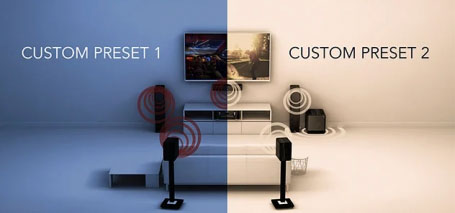
Obviously the major change in 2020 is the addition of HDMI 2.1 with support up to 8K resolution. But it’s both good and bad news as from one side the new port brings a few nice technologies with it that can really help in certain situations but on the other hand we lost two HDMI 2.0b inputs, including the front one which was very practical, in order to get one new HDMI 2.1 on the back. And if you add the problem that has been discovered with the 4K@120Hz signals resulting in black screens due to signal incompatibility then we cannot say that this year it is the clear step forward that we were hoping for.
OS, Apps and Features
In terms of settings and extra features there is almost no change from last year so this part of our review remains very similar to what we had observed in the NR1710. We will make appropriate changes wherever we will deem necessary.
Calibrating the NR1711 can become very easy for those that have no previous experience as the receiver comes equipped with the Audyssey MultEQ calibration system. The AV receiver comes with a calibration microphone and by using the built-in wizard that guides you step by step you can achieve very good results without the need to manually do any changes which can be very handy for casual users. As always for the best results a manual calibration is the best but from what we have seen the Audyssey system is an excellent assistant for novice and inexperienced users.
Along with the Audyssey system there are a couple more features that are included in the suite with the Dynamic EQ being one of them that keeps the dynamic levels as well as clarity even at low volume. The second feature that is included is the Dynamic Volume that balances sudden volume spikes when there are shifts between TV programs and commercials.
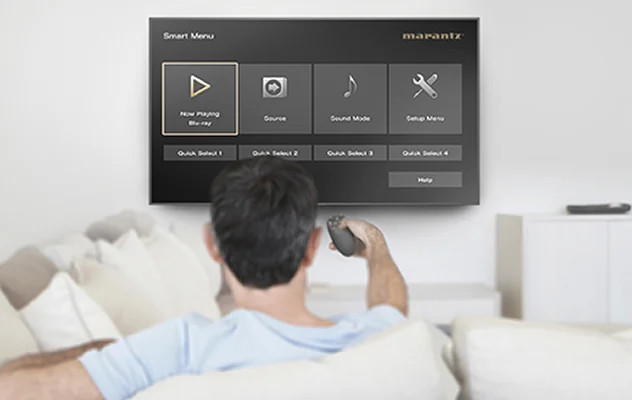
And while the built-in system includes all the basic settings if you would like to dig deeper into calibrating your system you can get the Audyssey MultEQ Editor App that can be downloaded for iOS and Android devices and make the necessary calibrations from there. The app has more settings and features and you can do a more advanced calibration of your system that would be otherwise impossible. The only minus of this, is the price as the app has a one time fee that you need to pay in order to download.
But Marantz has another app available and this one is free of charge called “Marantz 2016 AVR” remote app and with this you can have total control of the NR1711 from your mobile device. We had checked this app before in some of our previous reviews and we found it pretty good so since it’s free you can try and see if you like it.
Another thing that has remained the same in the NR1711 from previous years is that it features exactly the same setting menus. Having mostly the same capabilities and functions meant that there was no need for any major overhauling. All settings are separated into categories according to their appropriate function and everything was easy to find even with so many settings and features available. We have said before that at some point we would like to see a visual overhaul of the menus and get a visual design that comes a bit closer to what TV manufacturers have made as many AV receivers feel like they are stuck in early 2000.
As with all Marantz receivers, the NR1711 comes with an ECO mode that you can enable and let the receiver manage its power output in order to achieve power economy. But if you want the unit to perform at its peak power at all times then we suggest you to better leave this setting turned off.
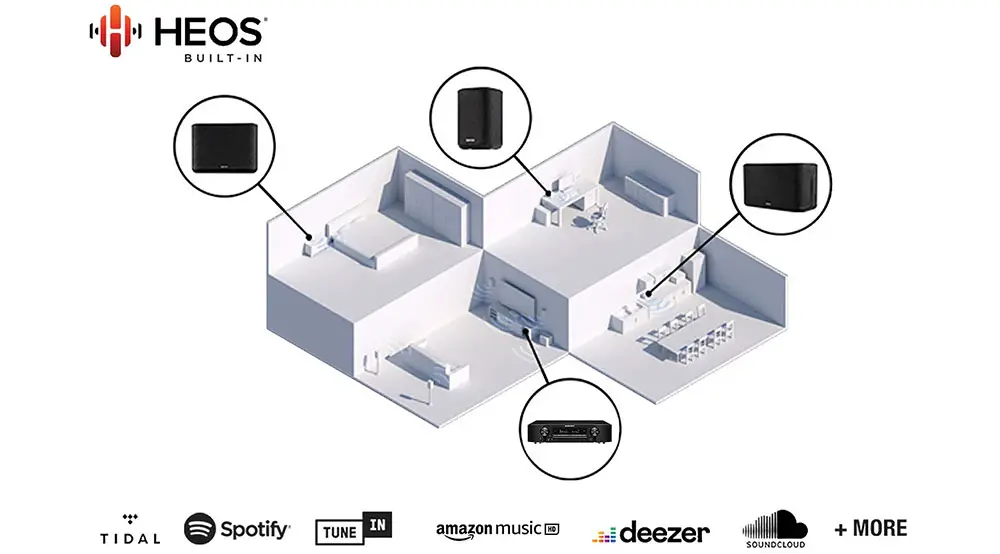
Marantz always included strong streaming capabilities to all their receivers and the NR1711 could not be any different. Streaming with the NR1711 can be done locally if you have a network server like a NAS connected or through the internet from one of the available streaming services available. The list includes many of the big names including TuneIn Internet Radio, Spotify Connect, Tidal, Deezer, Amazon Prime Music and Pandora among others.
With the receiver supporting both wired as well as wireless connections (2.4GHz and 5GHz) you can choose what is best for your given situation. But streaming capabilities don’t stop there as with Airplay 2 you can stream music from Apple devices through the use of Bluetooth if you are an Apple lover. And since we mentioned Bluetooth we should note that the NR1711 can also stream audio to Bluetooth enabled headphones.
We already mentioned above that the receiver supports USB streaming but we should also note that the unit comes with M-DAX2 support. Compressed music enhancement in Marantz slimline NR1711 is done by Marantz’ MDAX2 technology. The use of compressed audio files like MP3, Windows Media Audio or AAC is getting more and more popular.
The audio quality of these compressed files however is less than the original lossless files that are on a CD, especially lacking the higher frequencies and affecting the lower frequencies which make the audio image less wide and deep. The Marantz Digital Audio Expander 2, also called M-DAX2, recalculates the outputted frequency range. This enables you to get a more detailed and clearer sound.
Next comes the receiver’s multi-room capabilities. First we get the HEOS multi-room audio technology that you can use to connect the NR1711 with other HEOS enabled speakers you may have around your house. Similarly you can use Airplay 2 that does exactly the same job with speakers that are Airplay 2 enabled. And while streaming has definitely become the normal nowadays when it comes to multi-room environments the NR1711 also supports Zone 2 in order to connect a pair of speakers to a 2nd room or area.
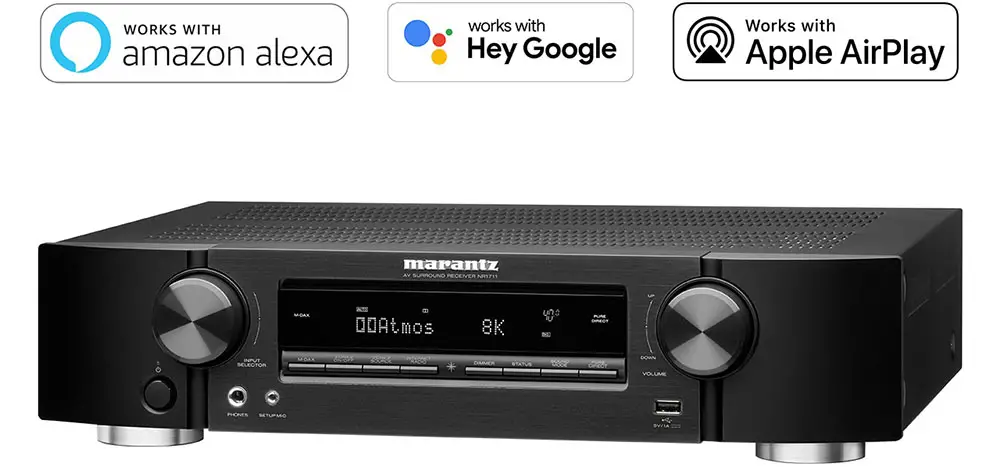
Voice control has become the standard lately so it couldn’t be missing from the NR1711 either. As such the unit supports all the known services including Amazon Alexa, Google Assistant, Apple Siri or Josh.ai. All of them need their respective external devices to be used obviously but it’s good to see that Marantz offers full support on this.
Marantz was always offering strong custom installation capabilities to their AV receivers and the NR1711 seems to be no different. The unit features OvrC remote system management technology, Domotz Pro remote monitoring and management technology with dedicated web interface to control and set up your AV receiver from a computer on the same network which can be extremely handy to custom installers.
Closing a few more features that are worth mentioning are HDMI-CEC, HDMI to HDMI upscaling to 8K@50/60Hz resolution, Bi-amp capabilities as well as being “Roon Tested” certified. For this last one there seems to be a bit of confusion as there are two types of certifications. Roon Ready and Roon Tested. The NR1711 is Roon Tested which means that if you use Airplay for example audio quality is limited to 16 Bit/44.1kHz. Keep that in mind in case Roon is specifically important to you but also want your files to be streamed in their original quality.
In terms of extra features the NR1711 continues to offer value over a small package. There are small changes over the last year but nothing major and the receiver offers almost everything you would find in most full sized units. A few features are still not supported like analogue to HDMI up-scaling or IMAX Enhanced support but these are not so important to be considered real omissions.
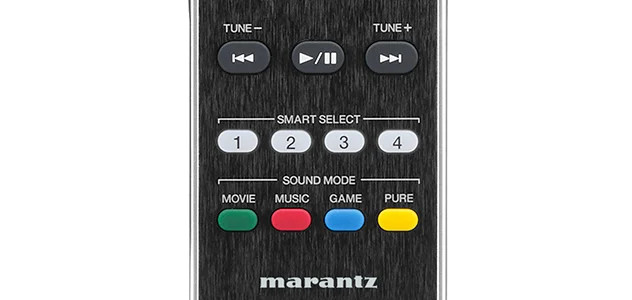
Final Thoughts
With another yearly release the NR1711 offers everything we found in last year NR1710 with a few additions that can be considered important or not depending on your needs. But what is certain is that the NR series continue to offer a lot of value in a small package and will certainly find its audience among the people that need something smaller than usual in order to fit in their limited space. Coming with a wide list of features Marantz thought that since these units would be used in relatively small spaces there is no need for more power output and it’s where we find the biggest difference compared to a fully sized model.
And for a unit that has almost half the size of a normal AV receiver what you get is both Dolby Atmos and DTS:X along with Dolby Surround, DTS Neural:X, Dolby Atmos Height Virtualization and DTS Virtual:X up-mixing and virtual technologies in addition to the Audyssey audio calibration system, support for HEOS and Airplay 2 multi-room tech, voice control, High Resolution Audio, online and USB streaming and HDMI 2.1 support with all the new technologies this brings. And all these with 50 watts of power that may not sound a lot but for a small room is enough and then some.
On the downsides the most obvious this year is the loss of two HDMI inputs, including the front one, in order to get a single HDMI 2.1 one. And if you include the 4K@120Hz debacle that affected all the new 8K AV receivers this year we can say that this new addition leaves a bittersweet taste to all new buyers. Not much else to note here but we still would like to see a backlit remote being included at some point.
Are the new 2020 additions enough to warrant a new release? Well, it depends on what you were expecting. HDMI 2.1 is huge but with the problems that appeared this year it’s not the feature that could warrant a new purchase. But if 4K@120Hz is not important to you the new HDMI port bring a few technologies that can be really worthy. The Marantz NR1711 continues to offer amazing value and is an excellent choice for all those that seek a fully featured AV receiver for their small room or media area but are extremely limited by space and are in need for a more compact solution.

For more reviews you can check our dedicated Slim Line 8K AV Receiver reviews list or even look at our Product Reviews Table where you can find the brand and specific product you are looking for.
Cheapest Places to Buy :
*We are a reader-supported website. When you buy through links on our site, we may earn a small affiliate commission at no extra cost to you. Home Media Entertainment does not accept money for reviews.*

We have an 8 year old Pioneer Elite receiver with 5 channels. It’s been great but we are thinking of upgrading. The Marantz, about which you have written, is much smaller but has more features than ours. The wifi and Bluetooth capabilities are so important with the entertainment stuff that available today. Your review was extremely detailed and thorough. This is definitely on our short list of receivers to replace ours. Thanks a lot.
Pioneer Elite are good receivers. If you need any further help with your purchase decision let me know.
Bigger is not always best and the NR1711 got me hooked. I will be adding it to my Christmas wish list as I was looking on buying a small AV receiver. The only drawback for me was the remote backlight not being present as I will be mostly using it in very low light. It being a bit on the expensive side, one would expect all ticks to be considered but all is not always perfect. Mostly I like the size and features. Well done on the well written review.
You are welcome. Let me know if you need any assistance.
Thank you for this thorough review. The step from 4K to 8K upscaling made me wonder if the upscaling as such is improved also for HD and 4K TV sets. I have a beautiful Sony LCD that has a mediodre upscaling from SD to HD. Hence my question.
Hello Maarten. Because the NR1711 can upscale to 8K it doesn’t mean that it can upscale SD content to HD and 4K even better that what the current 4K AV receivers can do. It just add the ability to upscale to even higher resolution. As far as its quality it remains the same with all the 4K models.
Thanks! In my situation this means that the NR1710 at a good price is sufficient.
If you don’t care about the new HDMI 2.1 features then I would agree that the NR1710 is a good option for you and you can save a bit of money this way.
Thank you again for this thorough review. We all truly appreciate it.
Do I really need the HEOS if I don’t intend to in multi room option?
Secondly you didn’t talk about the direct and pure direct options. Which is better? I intend to use it purely for listening to lossless audio and 4k Ultra HD movies.
Hello there. HEOS is not only for creating a multi-room environment but also to use it to stream audio from an online platform.
As for the Direct/Pure Direct thing what I can tell you is that their difference is so small that I am in disbelief that anyone can understand the difference between the two. Direct is supposed to pass the audio signal without any further processing by the receiver. So you get the mix exactly as it is supposed to be heard. Pure Direct is a similar mode but it switches off a few more circuits on the receiver in order to theoretically up the quality of the sound even further due to less electronic interference. Personally either of them will do fine and the difference, if any, is so small that doesn’t really matter which one you use.
Great review, thank you! Does this receiver get really hot or are the temps managed well? I wonder with the small size whether the components are crammed together which will cause future issues.
I can’t decide between this and the Denon AVR-x2700h either.
You have to think why you would consider the NR1711 or the X2700H. Does the slim factor of the NR1711 is something you seek? Because these two AV receivers are obviously on different categories with the 2700H being obviously a full sized model.
Great review! I consider to order this unit, cos of slim, small design. I would use it in a 4 x 3,5 m small living room, in 5.1 set up (MA Bronze 2 5.0 bookshelf sp. + Klipsch sw) 50-50 % featured films and tv programs or music listening (Tidal). What is your suggestion: is this will be fine (well detailed, powerfull) compared a same price ranged normal size AVR (e.g. SR5015) Thank you!
Hello Lazlo. For such a room in theory the NR1711 should be just fine. Obviously it depends how high you like to push the sound but for normal use you shouldn’t have any problems. If you are not extremely demanding the room space is ideal.
Hello Paul. At least during our test the receiver had a normal temperature for such a unit. Slightly hot but not to the point of becoming dangerous.
Γειά σου Στράτο.
Εξαιρετικό το review σου.Μπράβο!!!
Για έναν χώρο γύρω στά 20m² είναι ικανοποιητικός ο 1711;
Hello there! For average volume the NR1711 will do just fine for this space. But always it depends on how much you want to push it. If you are not sure I would suggest you to try it out in some retailer. But if in general you are not very demanding then I don’t see why it will not be enough.
I had the NR1711 and use it in a 3.5m x 6m space. I really enjoyed the 3d immersion of sound and not going overboard on volume at 56 on the dial max. I purchased the SR7015 and I swear the NR1711 did better and the SR7015 only showed some muscle at volume -64. I was not impressed with the AMP and I am returning it and buying the NR1711 again which is sufficient for enjoying movies. Do not waste your money, invest in better speakers with this AMP and you will have what you need for family enjoyment of music and movies.
Hello Asif and thank you for sharing your experience with the Marantz. Although I am a bit skeptical as to why the SR7015 did not perform better than the NR1711. The two of them are very far apart in terms of performance and the SR7015 should give you a very clear improvement. Maybe you hadn’t calibrated the unit correctly?
Bit of an odd question, do you know if the phono audio output will be feed through the eARC HDMI as well as the speakers?
Hey Wayne. It is indeed a bit of an odd question and I haven’t actually understood what you are trying to do. Please, if you can, explain me in more detail the kind of connections you want to make so I can help you more.
I’ll try to keep it brief, I have a TV with a very good soundbar included with it. However the soundbar doesn’t have any additional inputs, only from the TV. What I’d like to do to is feed my turntable into the phono on the NR1711 and get a audio feed out via HDMI, so my TV can output the audio to the soundbar. This cuts down on needing more cables to the attached sub and wouldn’t need additional speakers. The TV outputs Atmos via the soundbar, for clarity I have a 65oled934/12.
Now I understood what you are trying to do. OK look, I haven’t tried this myself but looking at the manual of the NR1711 I see that it has a setting in the HDMI setup menu called “HDMI Audio Out”. This can be set either to “AVR” (default setting) that play back through speakers connected to the unit or “TV” that play back through the TV connected to the unit. I think this is what you are looking for and in short answers your question.
It seems the 1710 is not available for purchase now. Having just purchased the 1711 and comparing the info sheets between the two, I see that the 1710 had 90 watts per channel, and that’s been reduced to 50 watts per channel on the 1711.
Hello Wayne. Both receivers have the same amplifiers. It’s 50 watts for 8 ohm, 20 Hz – 20 kHz, 0.08%, 2ch Drive and 90 watts for 6 ohm, 1 kHz, 1%, 1ch Drive.
Nothing has changed in this regard between the two so no worries.
Hi,
I am thinking of pairing nr1711 with pm8006. Rationale behind:
– AVR for PS4/5 and TV
– Stereo amp for turntable and spotify
Anyone has a similar setup (avr + stereo amp) and is willing to share experience?
Or maybe nr1711 has decent stereo section and phono stage?
Thanks,
Hello Radek. How do you plan on connecting these two? The NR1711 also supports Spotify through HEOS. The PM8006 has a higher rated amplification but other than that I cannot say if they use the same internals or not to know if there is an actual difference in quality between the two.
That is actually my dillema 🙂
Go with one-fits-all-size solution like e.g. AVR-X4700H / X3700H or have a separated AVR + integrated amp like mentioned above.
If latter then I am going to connect AVR with integrated amp via pre-out connection.
My current setup is based solely on avr, but I find it lacking in music quality department. Especially with analog section (turntable).
Which AVR you currently have?
Thank you for review and insight. I was considering NR 1711 to replace my dying integra receiver and power my Focal Chorus 800s. Looking for a temporary receiver (5 years) until the HDMI 2.1 8K issue is fully resolved. Additionally, thinking this is my excuse to get an amplifier (Black Ice F11/F22) and start the process to converting to separates (connect via pre-amps). My room is 20 ft wide by 40 ft deep but with the rear surround speakers at about 15 feet point. Or should I go with an alternative like the SR5015 or Denon AVR-3700H? Your thoughts would be greatly appreciated.
Hello Jeff. For that size of a room I would suggest a full sized AV receiver. Not that the NR1711 will not do and certainly I don’t know how much you like to push the volume but for that speakers and that room you need more juice.
Thank you for your insight and recommendation. Now I’m off to find your reviews of some of my other candidates. lol…
Anything you need let me know.
Hi Stratos,
If i connect a device to the composite or component inputs, will this be output through the HDMI at all (without upscaling as i know it won’t upscale those)?
Cheers
Hello Chris. Unfortunately no. If you input from the component port the AV receiver will output from the component port. The same with the composite and HDMI. It will only output from the same type of port you input the signal.